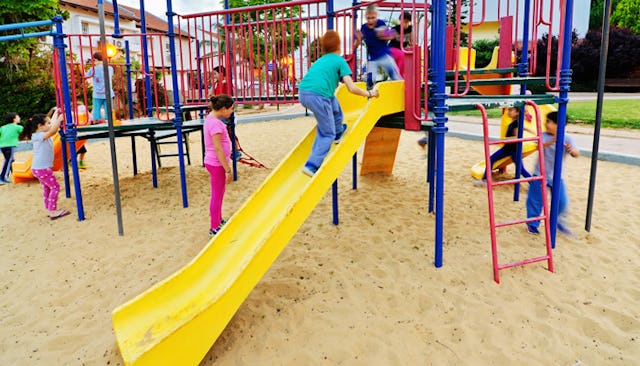The Great Slide Debate

OK, I confess: I let my kids climb up the slide.
Some of you are gasping and shaking your fists. Others are shrugging. Apparently, I discovered recently, the Great Slide Debate is one of the throw-down, gloves-off, all-out mommy wars. We’ve all heard the old playground mantra: up the stairs and down the slide. Based on the responses I saw to a recent piece, you’re either an up-the-stairs, down-the-slide parent or a sure-go-on-up type.
And the up-the-stairs-down-the-slide crowd really, really hates the other. One mother said that kids who went up the slide were bullying others who would then be too shy to go down the slide. Another said that if parents weren’t enforcing the rule, she had no problem telling other people’s kids not to climb the slide. “Ladders are for climbing,” says one commenter. “You’re teaching them how to interact with and in society … that is basic fundamental parenting!” Universally, the moms complained about lazy parents who wouldn’t enforce basic playground rules.
Let me assure you, I know the basic playground rules. I’ve even told my kids to obey them a time or two. But I believe that half the function of a slide is to climb up it. As long as no one’s in line to go down, I think kids should have the chance to climb and clamber and slip up to their hearts’ content. It’s just as important, I think, as going down.
Going up the slide teaches basic bodily awareness. It stimulates the vestibular system, and the resulting downward slips help teach children to fall safely. Most children don’t get enough movement in their lives. It simply gives them better balance. And better balance in childhood can lead to better balance in adulthood.
Climbing the slide lets my kids test their limits safely. How high can they get? Can they make it? When will they slide back down? These attempts build confidence, both physical and emotional. Even if my kids fail (and they usually do), there’s a sense of accomplishment and hard work that goes along with slide-climbing. They try lots of different holds and foot positions. It helps them place their body in space.
Most importantly, I don’t want my children to think they have to use their playthings in the manner someone else has dictated. If everyone is sliding down, climbing up becomes a creative act. This teaches them to question the world around them in a safe way, starting with the playground.
The up-the-stairs, down-the-slide crowd is howling mad about now. How dare I put my kids’ chance to question authority up against Junior’s right to slide down the slide? First, it’s only OK to climb up the slide when no one’s in line to come down it. If that’s the case, I fail to see how it’s interfering with their child’s play experience.
I understand that they may not want their kids climbing up the slide, and my kids might be setting what they think is a bad example. That’s a good chance to talk about how different parents make different rules. I refuse to curtail my kids’ enjoyment because you think they’re a bad influence. If you don’t want your kids climbing up the slide, stop them. But don’t stop my kids, who know Mama says they can go up the slide if no one’s waiting.
My kids also understand that the slide is, primarily, for going down. They know they can’t climb when there’s a line. And they know that if they do, they might get a well-deserved foot in the face. That’s another life lesson there.
More than anything, though, going up the slide is fun. I did it. You did it. You remember the exhilaration, the careful negotiation of foot and hand, the sense of pride and accomplishment when you made it to the top — likely to slide right back down again. I won’t deprive my kids of that sense of fun. I’m sorry if you deprive yours of it.
So my kids are slide-climbers. When you see us at the park, be warned. We’ll stay out of the way when your kids are coming down. But when they’re not, my kids have the right to go up. It’s part of a normal childhood. And damn it, I’m going to give it to them.
This article was originally published on